Fruitcake in Space
Behind the scenes of my first reported audio story
An announcement!
My first reported story for the Southern Foodways Alliance’s Gravy podcast debuts today! I’ve been working on it since last year, and I’m so proud that it’s finally here. You can find it here, or on any of your preferred audio platforms under the Gravy podcast - Fruitcake in Space.
I tell the story of a woman named Mary Klicka, who worked on a peculiar fruitcake recipe for a military laboratory in the 1960’s. The fruitcake was developed to be a single-item, nutritionally-fortified emergency ration… for astronauts. If needed, a crewmember could survive by eating this fruitcake alone for up to three years.
In reporting this story, I learned that this fruitcake is more than just a throwaway anecdote in NASA’s early history. It illuminates the complex labor of selecting and preparing food for space travel, and how this work can shape the success or failure of scientific missions. It’s something I’ve been thinking about a lot in this era that pits biohacked nutrition with its powders and bars against the increasing demonization of processed foods. Ultimately, how we obtain the necessary calories to survive in space is a delicate balance between nutrition science, technology, and the cultural significance of a meal.
I talk to Vickie Kloeris, the former manager of NASA Food Systems, Jennifer Levasseur, a curator and specialist on space food artifacts at the Air and Space Museum, and Cady Coleman, a retired NASA astronaut. I’m incredibly grateful to these women for lending me their time - I had to trim down several hours of discussion for the roughly 26 minutes featured in the podcast, and it was SO HARD.
Today in the newsletter, I want to share some details about this story that you won’t hear in the podcast.
How did I find this story?
I have my wife to thank for that! I’ve been mulling over a fruitcake-focused project for some time. I had a fruitcake aging club during the pandemic and have written about it for the Washington Post.
I’ve also had a long-time fascination with the space program, rooted in childhood trips to the National Air and Space Museum. That’s how I happened to see this pop up on the museum’s Instagram feed:
This fruitcake specimen flew all the way to the moon and back and now lives in the museum’s archives. I immediately needed to find the original recipe. My wife Sophie sometimes follows me down these rabbit holes, which led her to look up the term “nasa fruitcake” on Google Scholar and scroll through some of the results. That’s how she found Mary Klicka’s report, part of a whole host of declassified research available through the Defense Technical Information Center.
We both promptly lost our minds: a fruitcake developed to be the sole emergency ration for astronauts for up to three years?! I had to learn more.
For what it’s worth, I did ask the Air and Space Museum if I could actually see the Apollo fruitcake, but it wasn’t possible (I got an incredible interview with a museum curator instead).
Why a podcast?
I’ve been telling folks about Klicka’s fruitcake for several years now, and two of my pals (both named Nicole!) told me it should be a podcast. This seemed crazy to me - I assumed that I’d need year’s worth of technical knowledge to pull it off. My friend Katie Fernelius, reporter and seasoned podcast producer, convinced me to pitch it to Gravy anyway. Katie also co-produced the episode with me (aka lending me all the equipment I needed, patiently teaching me how to use it, and answering all of my million questions). I’m incredibly grateful to her for pushing me to do this. Katie is currently a senior reporter for Verite News in New Orleans, doing vital local investigative journalism: like this piece on a local tech partnership gone wrong, or this piece on the contract to build a controversial temporary homeless shelter. Katie is also a producer on the podcast A Field Guide to Gay Animals, among many others.
In addition to all of the recording equipment, Katie lent me the book Out on the Wire: The Storytelling Secrets of the New Masters of Radio by Jessica Abel. Abel is a cartoonist and the book takes the form of a graphic novel, featuring interviews with a host of radio and podcast producers who are now household names. I found it incredibly helpful in thinking about how to shape an audio story - it’s so different from writing an essay!
On Katie’s recommendation, I used the program Descript to cut together the audio for the podcast. It’s a surprisingly intuitive tool that allows you to re-arrange audio clips as blocks of text in a transcript. The final version was mastered by Clay Jones of Broadcast Studio in Oxford, Mississippi, who also wove in some of the music for the episode. I worked with Sara Camp Milam and Olivia Terenzio of the Southern Foodways Alliance to edit and shape the story, and Lisa Pollak fact checked the episode.
Recreating the fruitcake
I always knew that I wanted to bake Klicka’s fruitcake for this story, and part of the audio of that process made its way onto the podcast. I didn’t have room on the pod to discuss how I actually sourced the recipe.
Klicka’s research has been referenced before a handful of times, and a version of the lab’s fruitcake recipe can even be found in a children’s book for National Geographic Kids called Food Fight: A Mouthwatering History of WHO ate WHAT and WHY Through the Ages by Tanya Steel. This recipe didn’t feel quite right to me, though - it uses 6 eggs to one cup flour, for one thing, and lists walnuts as an ingredient even though I knew from Klicka’s original report that they used pecans. Quote:
“Nuts shall be pecan pieces and shall conform to the standard for U.S. No. 1 pecan pieces, small pieces as defined in U.S. Standards for Grades of Shelled Pecans or Almonds”.
The report does contain the “recipe”, presented as ratios of ingredients, which is often how professional bakers think of recipes anyway:
While I could certainly have used these percentages to model my own recipe, I was distracted by another tempting reference to hunt down - a version of Natick’s recipe that had been distributed to newspapers in the late 60’s and early 70’s. I found two references to this via foodtimeline.org, a delightfully old-fashioned research website that offers full citations from actual texts, compiled by a woman named Lynne Olver. The website dates from 1999 and looks it, but the information can be invaluable. From there, I learned that the Gettysburg Times wrote a story called "Moonmen's Fruitcake Recipe Given” on December 16, 1972. Thrillingly, Google News had a digitized copy of the newspaper. I didn’t find it in the December 16th edition, but rather the December 18th:
I’d email Olver to correct the date, but she passed away several years ago. Ultimately her citation led me to the recipe I used to recreate the fruitcake (soy flour, glacé cherries, and all). You can find the full recipe here. Shout out to my pal Camille, who let me come to her restaurant and use the vac sealer for this photo.
In the upper right hand section of this next photo, you can see a shot of NASA fruitcake as it was packaged during the Mercury era.
Food kit used by Mercury astronauts. Some is dehydrated and needs water, other packets are ready to eat. Size is measured relative to a ruler. Included are packets of mushroom soup, orange-grapefruit juice, cocoa beverage, pineapple juice, chicken with gravy, pears, strawberries, beef and vegetables and other assorted food containers. Photo credit: NASA
Eerily similar, no?
My biggest regret
I really wanted to include audio of Apollo astronauts discussing fruitcake while in space on the podcast, but ultimately I was unsuccessful.
The records for the food brought on the Apollo missions are extensive and publicly available, so I knew, for instance, that fruitcake was present on the lunar module of Apollo 11 for Neil Armstrong and Buzz Aldrin’s historic first steps on the moon. All of the audio from communications on the lunar surface is also available with annotated transcripts, a passion project by a civilian named Eric Jones that NASA itself links to as part of the historical record of the mission. This allowed me to control-f for the word “fruitcake” through all the transcripts of every mission, which I painstakingly did.
Unfortunately, not all of the audio from the on-orbit communications (versus those on the moon’s surface) of the earlier Apollo missions is currently online - though you can still read the transcripts. This meant I couldn’t include my favorite conversation, between astronauts James McDivitt, David Scott, and Russell Schweickart during Apollo 9 in 1969:
194:42:34 Schweickart (onboard): Hey, since there's so many of those fruitcakes left, I may just take another fruitcake. That really tasted good.
194:42:39 McDivitt (onboard): Did it? Man alive, you can have all of mine.
194:42:41 Schweickart (onboard): Really?
194:42:42 Scott (onboard): Hey, give me a bite of it.
194:42:43 Schweickart (onboard): That's a deal.
194:42:47 McDivitt (onboard): Give me a bite out of it; I haven't had one of those things. [Garble] a thousand of them.
194:42:52 Schweickart (onboard): Fruitcake?
194:42:53 McDivitt (onboard): Yes.
194:42:54 Schweickart (onboard): God damn! I'm going to - I'm going to add fruitcake to my diet. Hey, you know, we're getting compatible.
Part of the issue is that the original copies of the Apollo air to ground communications are on analog tapes. I found a record of a 2012 project at UT Dallas, where a group of professors and graduate students were beginning the painstaking process of digitizing these rest of the tapes - you can find some of their work here, though it doesn’t seem to have been updated since 2016. I did email NASA to ask for an update (no reply as of yet).
This wasn’t the only discussion about cake on Apollo 9. The astronauts were informed in advance that a 350 pound cake was being baked in their honor and would be served to them aboard the USS Guadalcanal, the recovery ship responsible for picking them up after their orbital vehicle, the command module Gumdrop, splashed down in the Atlantic. Over the course of the mission, the astronauts frequently muse about the cake:
165:49:05 Schweickart (onboard): Guess what, David. When your face feels better, breathe less skin. Besides that, we like you to look good.
165:49:16 Scott (onboard): Right. You got to be handsome.
165:49:18 Schweickart (onboard): Right. None of this recovering looking like that - We got to stay up here 2 more days just so that we can look good when we eat that 350-pound cake. Right after that, three 8-foot-tall redheads.
165:59:39 McDivitt: Hey, Stu, were, you the fellow who told us about the big cake on the Guadalcanal?
165:59:44 Roosa: Yes, I mentioned that.
165:59:46 McDivitt: Well, ever since you mentioned it, Rusty and Dave haven't stopped talking about it.
165:59:51 Roosa: I sure am sorry about that. Maybe we better send a TWX out there and have them make that a 700 pounder.
176:19:55 McDivitt (onboard): I don't think there's anything on the whole menu I want. Just take whatever is least - least undesirable.
176:20:02 Scott (onboard): That's the way I feel, but it's got to go. Oh! That 350-pound cake! I wonder if it's chocolate?
176:20:08 Schweickart (onboard): I tell you. I don't like cake very much, but that still sounds good. [Garble] a 350-pound pie would interest me more.
176:20:18 Scott (onboard): But chocolate cake with ice cream? Ahh! I could eat and eat and eat.
All in all, the astronauts bring up the cake at least 17 times during the course of their eleven-day mission. Here they are with it:
The Apollo 9 crew prepares to cut the 350-pound cake which was baked on the U.S.S. Guadalcanal in their honor. Left to right, are Astronauts Russell L. Schweickart, David R. Scott, and James A. McDivitt. Looking on at right is Capt. Roy M. Sudduth, commanding officer of the U.S.S. Guadalcanal. Photo credit: NASA.
To be totally honest, it doesn’t look like it weighs 350 pounds to me!
Moving on- I found one, quite degraded, soundbite of Astronaut Jim Lovell describing using the astronaut’s edible toothpaste as a frosting for fruitcake during Apollo 8 (edible, because you can’t spit into a sink in space). Ultimately this clip was so short (and staticky) that it didn't make the cut.
Regretfully, I’ll have to wait until the Apollo 9 audio is eventually available for my dream soundbites as a lover of both space and cake. In the meantime, you can find the air-to-ground communication transcripts for all of the Apollo missions here.
The biggest challenge
Probably the hardest part of scripting the podcast was weaving in real-time news updates regarding Suni and Butch, the astronauts who were until recently “stuck”1 on the ISS. I was ecstatic when Vickie Kloeris, the now-retired former manager of NASA food systems, brought up this tricky situation organically during our interview (you’ll have to listen for that full context!). The week I recorded my narration for the podcast was also the week Suni and Butch were due to return. I ended up having to simply state “as of this date, Suni and Butch are due to return in a matter of days”.
NASA astronaut and Expedition 71 Flight Engineer Suni Williams celebrates her birthday during International Talk Like a Pirate Day aboard the International Space Station. Sitting on the Unity module's gallery is a pair of strawberry cakes for her and crewmates to enjoy. Items are attached to the galley using tape and velcro to keep them from flying away in the microgravity environment. Photo credit: NASA
I watched the launch of the replacement crew live (their vessel would serve as Suni and Butch’s return ship). There is something truly awe-inspiring about seeing the liftoff of a crewed mission - my heart was in my mouth the entire time. I know that the continued existence of the space program can feel problematic when the planet is currently facing so many profound problems. I haven’t entirely squared these feelings myself - all I can say is that I’m aware of the counterarguments but maintain a deep belief in the value of publicly funded space exploration.
Another complication occurred any time I described the proposed timeline for the Artemis mission, which is supposed to be NASA’s upcoming return to the moon. That (along with everything else) depends on the whims of the Trump administration, who have the power to scrap the entire program. NASA has long promised that Artemis will put the first woman and the first person of color on the moon, but considering the fate of the rest of the government’s DEI programs, it seems certain that the objectives of the mission could shift dramatically. In fact, NASA’s website no longer lists putting a female or Black astronaut on the lunar surface as one of Artemis’ stated mission goals. Again, two things can be true: I can understand the limitations of identity politics while also being heartbroken that NASA could rescind this goal. While the agency has said in a statement to media that the removal of the language does not indicate a change in crew assignment, they haven’t yet revealed the selected astronauts for Artemis III, the first of those missions to actually land on the moon’s surface.
Elon is obsessed with Mars, and if he still has Trump’s ear, he might continue to push for that planet instead. I’ve been reading journalist Swapna Krishna’s coverage to help me understand what might happen next. Today, Trump’s pick to head of NASA will testify before Congress. He has reiterated that Mars is the administration’s priority, but hasn’t ruled out using the moon as a stepping stone (which was NASA’s goal all along).
If you’d like to learn more about the history of space food you should check out Vickie Kloeris’ memoir, Space Bites: Reflections of a NASA Food Scientist. To learn more about Cady Coleman’s remarkable career, you can read her recently published memoir, Sharing Space: An Astronaut’s Guide to Mission, Wonder, and Making Change. To see Mary Klicka interviewed on camera, you can watch the 1966 short film “Food For Space Travelers” by the MIT Science Reporter here - her segment begins at 19:27.
NASA astronaut Catherine (Cady) Coleman, Expedition 26 flight engineer, prepares to eat a snack in the Columbus laboratory of the International Space Station. Photo credit: NASA
Rather than saying “stuck”, its more accurate to say their mission was extended, and they certainly weren’t “stranded”.







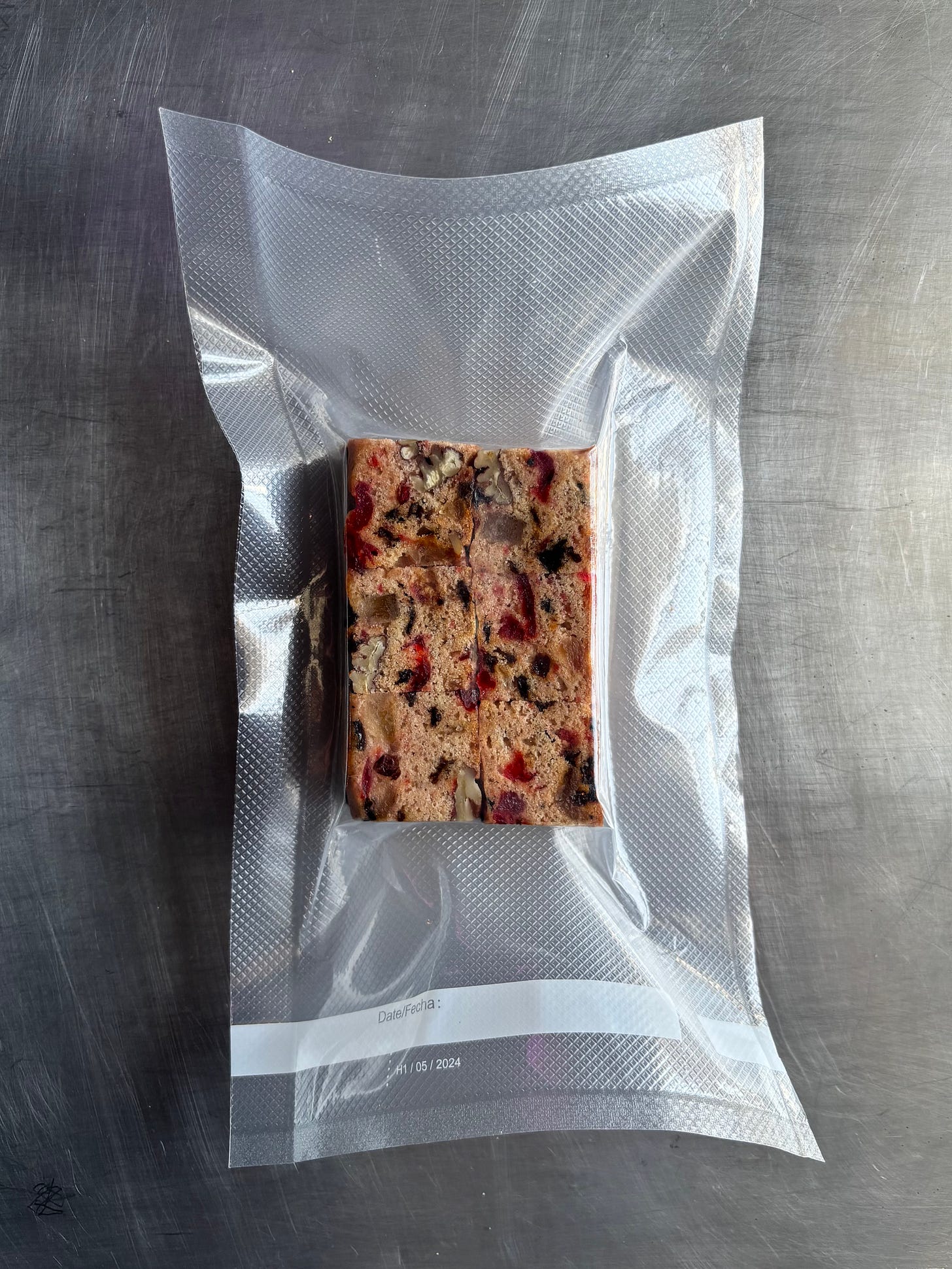
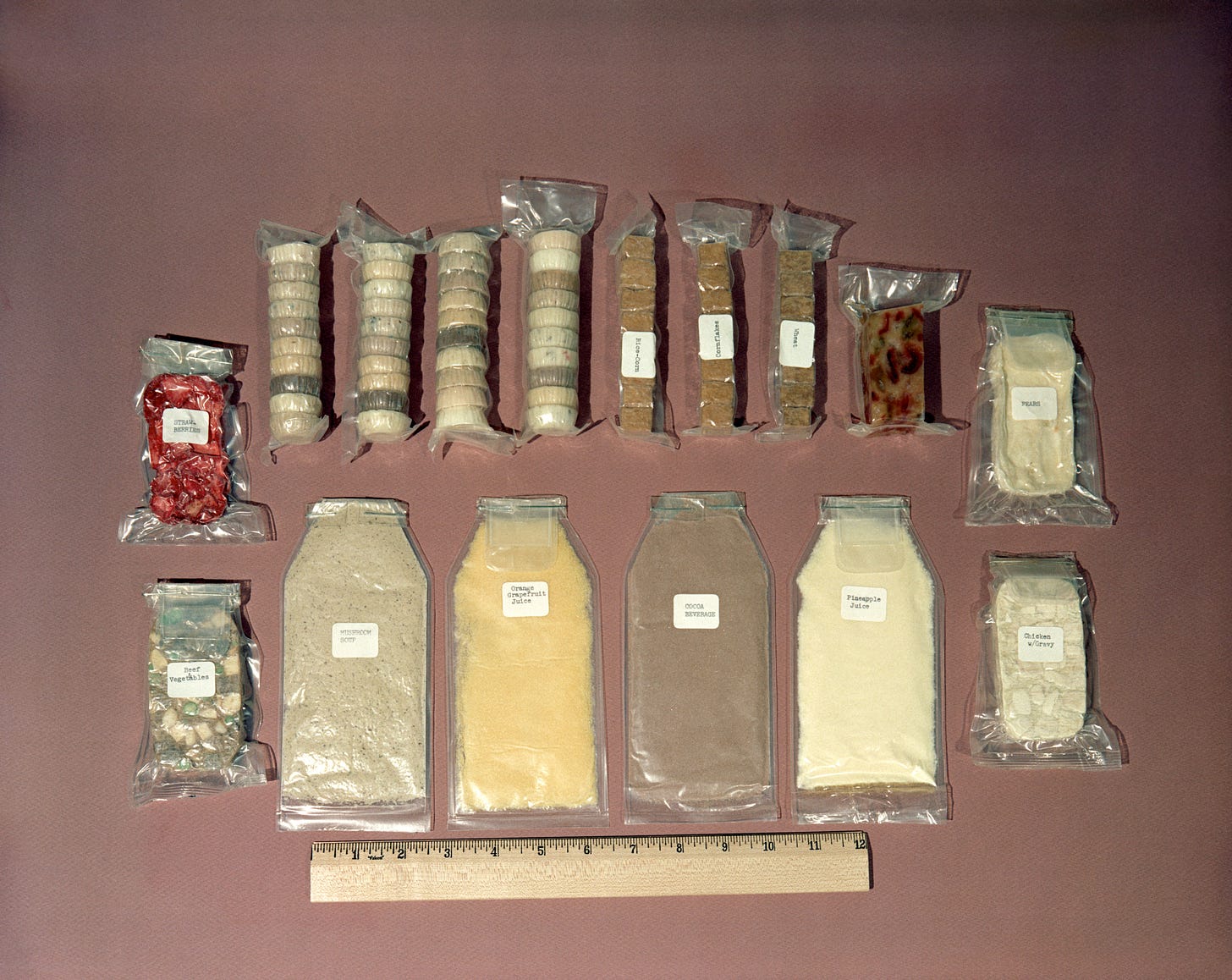
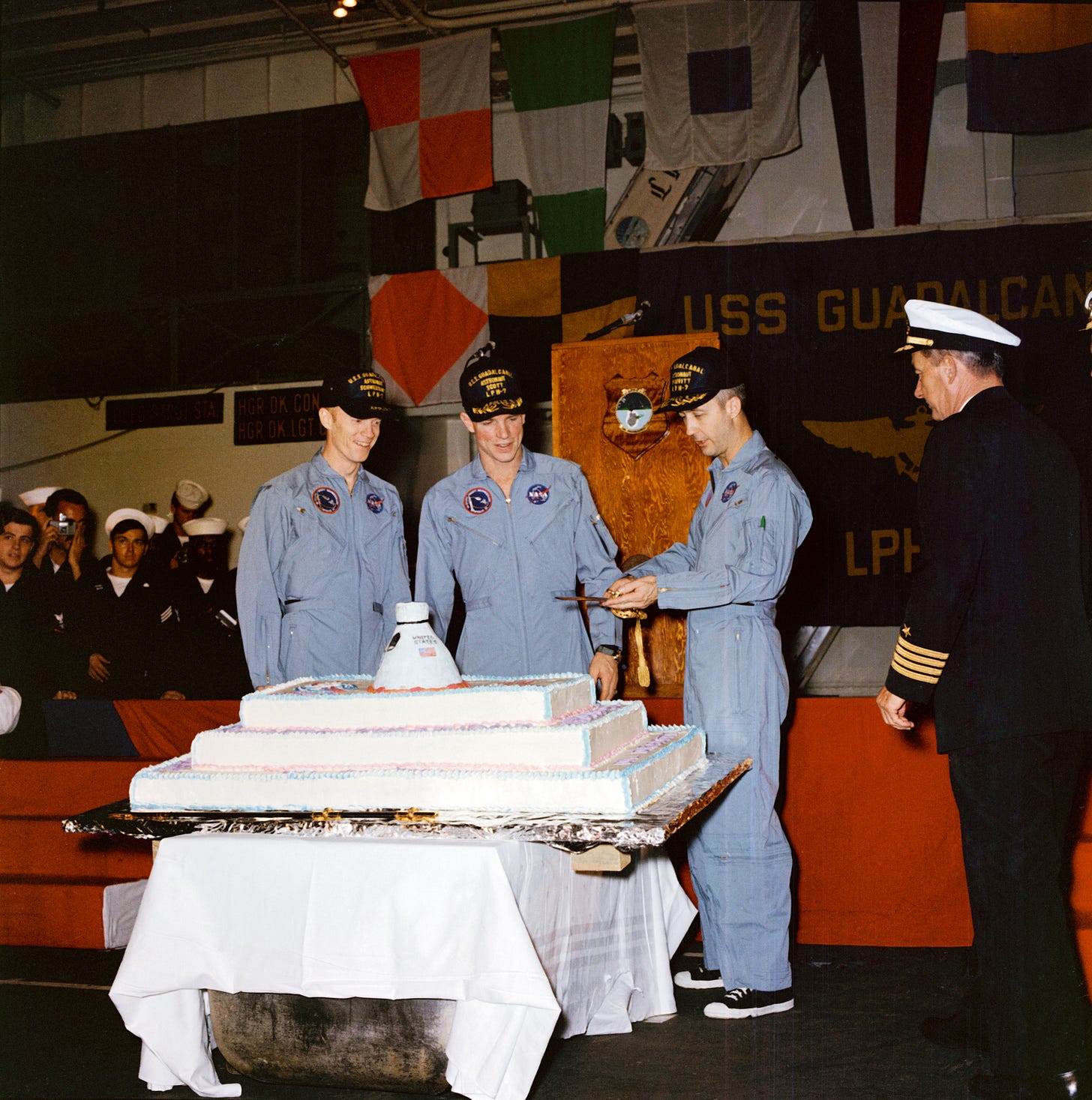
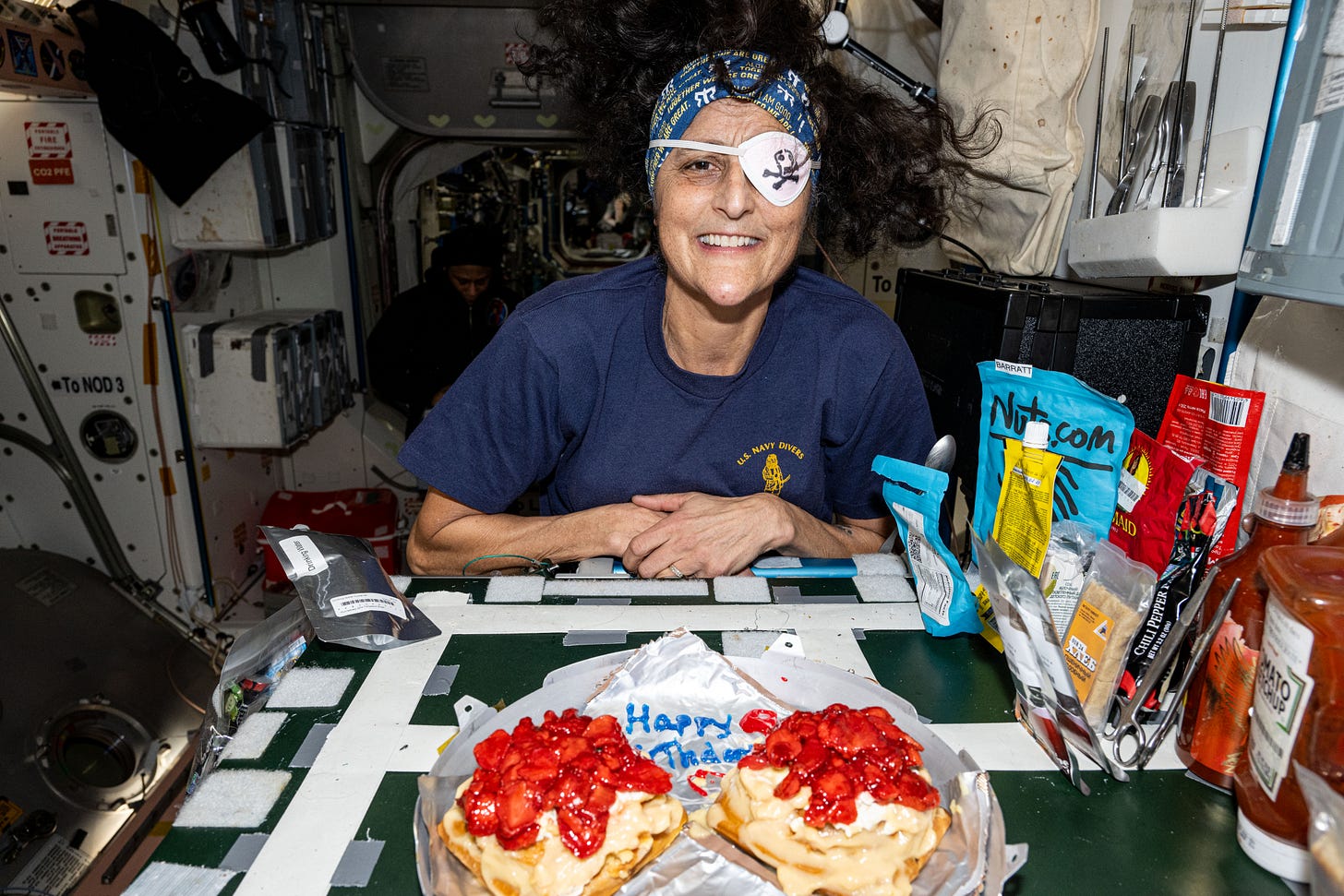
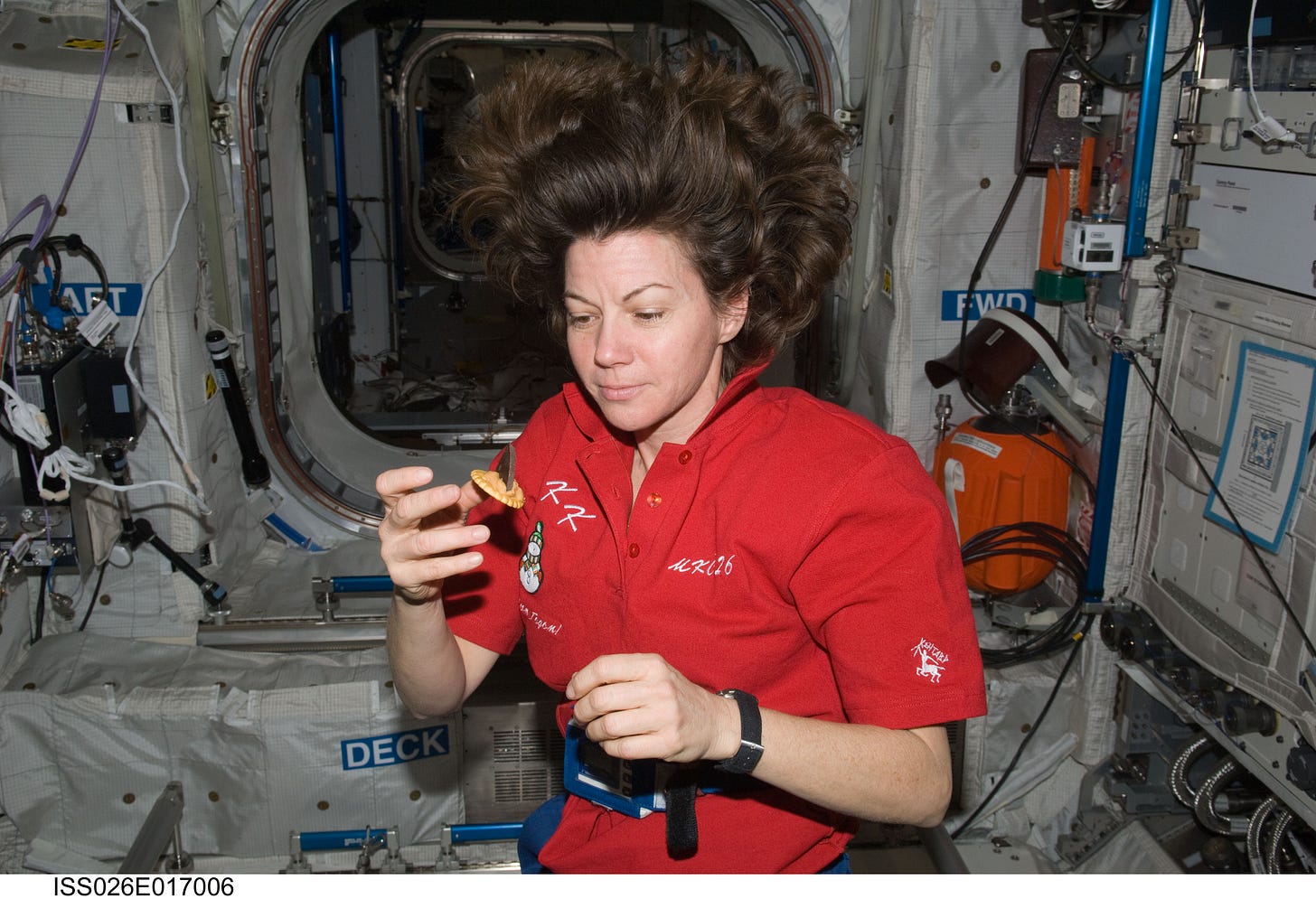
It was a DELIGHT to play a small role in helping your brilliance come to the ~airwaves~! So grateful for your infectious curiosity and passion for fruit cake and space. 👩🏼🚀🚀
I listened! It was fascinating. Great work! (And I was among the guilty who believe all space food is freeze-dried)